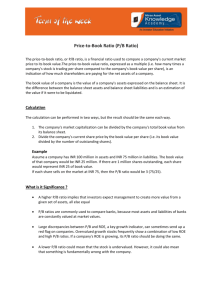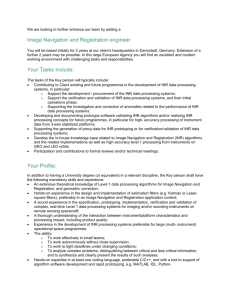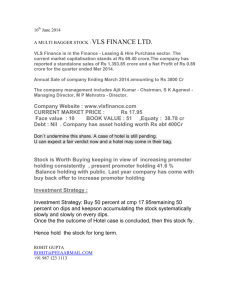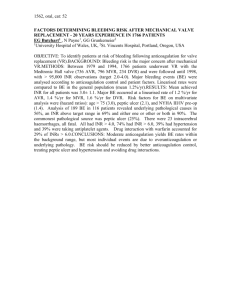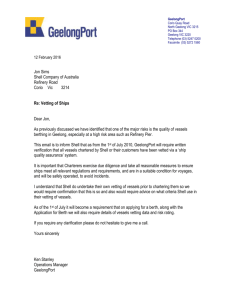proposal for upfront tariff setting for a 4 mmtpa coal import terminal at
advertisement
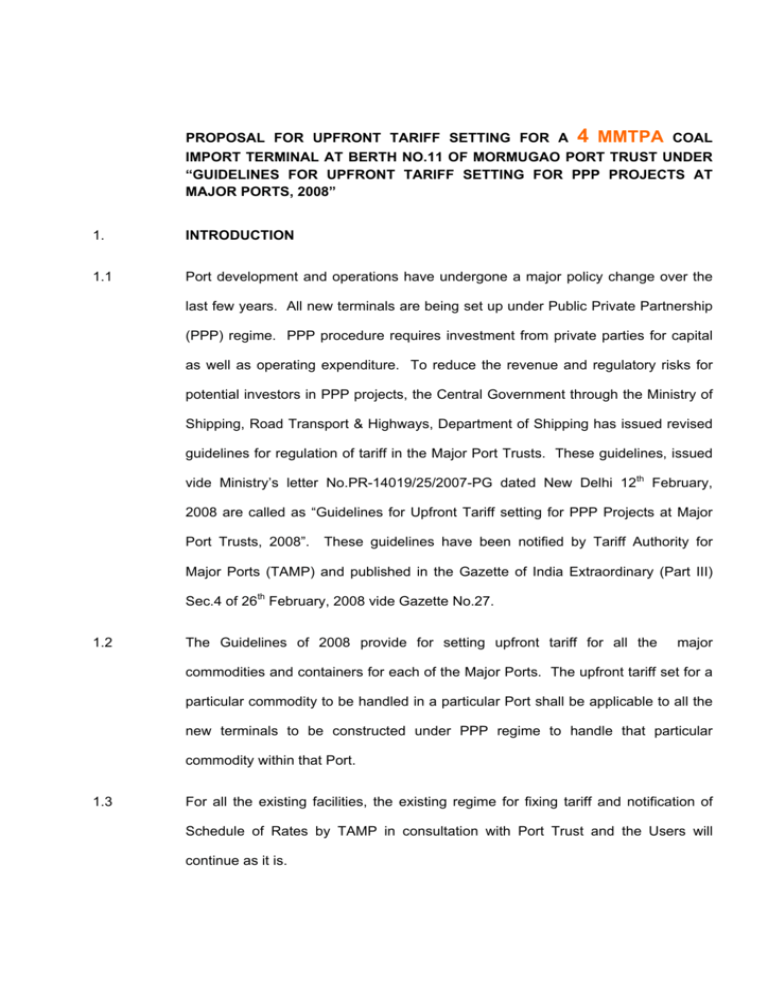
PROPOSAL FOR UPFRONT TARIFF SETTING FOR A
4 MMTPA
COAL
IMPORT TERMINAL AT BERTH NO.11 OF MORMUGAO PORT TRUST UNDER
“GUIDELINES FOR UPFRONT TARIFF SETTING FOR PPP PROJECTS AT
MAJOR PORTS, 2008”
1.
INTRODUCTION
1.1
Port development and operations have undergone a major policy change over the
last few years. All new terminals are being set up under Public Private Partnership
(PPP) regime. PPP procedure requires investment from private parties for capital
as well as operating expenditure. To reduce the revenue and regulatory risks for
potential investors in PPP projects, the Central Government through the Ministry of
Shipping, Road Transport & Highways, Department of Shipping has issued revised
guidelines for regulation of tariff in the Major Port Trusts. These guidelines, issued
vide Ministry’s letter No.PR-14019/25/2007-PG dated New Delhi 12th February,
2008 are called as “Guidelines for Upfront Tariff setting for PPP Projects at Major
Port Trusts, 2008”.
These guidelines have been notified by Tariff Authority for
Major Ports (TAMP) and published in the Gazette of India Extraordinary (Part III)
Sec.4 of 26th February, 2008 vide Gazette No.27.
1.2
The Guidelines of 2008 provide for setting upfront tariff for all the
major
commodities and containers for each of the Major Ports. The upfront tariff set for a
particular commodity to be handled in a particular Port shall be applicable to all the
new terminals to be constructed under PPP regime to handle that particular
commodity within that Port.
1.3
For all the existing facilities, the existing regime for fixing tariff and notification of
Schedule of Rates by TAMP in consultation with Port Trust and the Users will
continue as it is.
1.4
In this proposal, the Mormugao Port Trust seeks the approval of the Tariff Authority
for Major Ports (TAMP) for setting upfront tariff for a 4 MMTPA coal import terminal.
The proposal is based upon the Guidelines of 2008 for upfront tariff setting with
modification to take care of variation from norms in respect of storage.
2.
Factors considered for designing an optimal coal import terminal at berth
no11 in Mormugao Port Trust
2.1
Mormugao Port Trust is located on the West Coast of India within the state of Goa.
This 125 years old Port was established by the Portuguese rulers of Goa. The
Portuguese Engineers selected the estuary of the river Zuari for constructing the
Port because it offered excellent tranquility, natural harbour and very good natural
depths. Over the last 5 years, the Port has grown by leaps and bounds and today it
is known for its deep draft channel capable of taking in Cape size vessels for part
loading, vibrant community, co-operative workforce and trade-friendly attitude.
2.2
The biggest asset of Mormugao Port Trust is its navigation channel which is of (-)
14.1 mtrs. depth below the Chart Datum. Hence the proposed new optimal coal
import terminal has been designed for handling fully loaded Panamax vessels .
Looking at the existing trends, at the moment the Port does not expect to receive
Cape size vessels carrying coal. However, the facility is proposed to be created at
the new terminal for handling Cape size vessels because the Trade feels that over
the next few years, as the channel is deepened further, fully loaded Cape size
vessels can also be received and handled at the existing and proposed berths
themselves and can sail out fully without the need of uploading at outer anchorage
of MPT. The vessels carrying imported coal for discharge at Berth No.11, and the
other berth at MPT handling coal, can be loaded with iron ore to be to be exported
and can sail out fully loaded when the depths are deepened to (-) 17.4 mt below the
CD.
2.3
Though the Port has the advantage of depth, it has a major disadvantage of having
an extremely limited land area. Most of the existing facilities have been created
over reclaimed land. Cost of reclamation is quite high because the environmentallysensitive state of Goa has very few quarries. While designing the optimal coal
import terminal the existing berth no.11 is proposed to be shifted forward parallely
by 22 metres , thereby creating a new quay capable of receiving capsize vessels in
future. The construction of new berth no.11 will also make available 6842 sq.mtrs (
311 mtrs length X 22 mtrs width) of the existing berth/quay and back up land area
for installation of cargo handling equipment.
2.4
Mormugao Port Trust (MPT) provides port related services and facilities to the
Trade and commerce of mainly state of Goa as well as parts of Karnataka and
Maharashtra. While the state of Goa is served through connectivity by way of
inland waterways,rail and road, parts of Karnataka and Maharashtra are served by
rail and road. Both the South Western Railway and Konkan Railway provide rail
connectivity to the Port. The optimal proposed coal import terminal at Berth No.11
of Mormugao Port Trust will have facilities for loading the imported coal into railway
wagons. No coal is expected to be taken away from the Port by road. The terminal
is to be built for importing coal/coke/limestones etc., for the Goan as well as
Karnataka steel and power industries. The demand for coal is projected to pick up
significantly in the new future and is expected to remain high in the medium time
frame due to the setting up of various steel and power manufacturing units, mainly
in Karnataka.
2.5
Besides the above general factors, the specific parameters used for arriving at the
tariff are described along with the calculations in the following paragraphs.
3.
Estimation of capacity
3.1
Optimal capacity of the coal import terminal has been determined taking into
consideration various components of the facility that will be required to be created,
equipment and plant and machinery to be provided, productivity levels and
utilization levels, as per the norms prescribed.
Tariff shall be prescribed with
reference to the optimal capacity of the terminal irrespective of any traffic forecast.
3.2
The optimal capacity of the terminal is reckoned as 70% of the maximum capacity,
and the lower value of the optimal quay capacity and optimal storage capacity.
4.
Estimation of optimal quay capacity
4.1
The optimal quay capacity is 70 % of the maximum or possible quantity of coal that
can be loaded into the ship in a period of one year expressed in tonnes.
Optimal quay capacity
S1
S2
S3
* P1 +
* P2 +
* P3
100
100
}* 365
Optimal Quay Capacity = 0.7 *{ 100
S1
-
Percentage share of capacity of capesize vessels
P1
-
Ship day output of capesize vessels
S2
-
Percentage share of capacity of Panamax
Vessels
P2
-
Shipday output of Panamax vessels
S3
-
Percentage of share of capacity of Handy-size and
Handymax Vessels
P3
-
Ship day output of Handy size/Handymax vessels
S1, S2 and S3 are to be determined taking into consideration the draft availability
and type of vessels expected to be handled at a particular port.
4.2
At Mormugao Port, the depth of channel is (-)14.1 mtrs. below the Chart Datum and
a tidal variation of about 1.8 mtrs. on an average is available. With this advantage
of a deep draft channel, the Port can handle partially loaded Cape size vessels and
unload fully Panamax/ post panamax/ camsar max size vessels as well as handy
max vessels. Inquiries with the Trade and the existing pattern of composition of the
shipping fleet leads us to conclude that any new coal import terminal would be
getting 80% Panamax vessels and 20% Handymax vessels. No capsize vessels
carrying coal whether partly loaded or fully loaded call at MPT. Hence, the
percentage of capsize vessels is taken at NIL. This has been the approximate
general trend at the port of Mormugao in respect of imported coal. While the
panamax vessels as well as handymax will generally be gearless, few geared
vessels depending on freight advantage to the shippers may also be unloaded.
Choice of ships is by the buyers as at Mormugao Port, as almost all the coal
imports are on FOB basis. Sometimes they are also high sea C&F sales.
4.3
The norms for ship day output for various types of vessels are defined in the
guidelines and reproduced below:
Norms for Ship-day output
Type of Ship
Unloading
Capesize
50,000 tons/day
Panamax
35,000 tons/day
Handy Size & Handy max
15,000 tons/day
Using the above norms and the formula, the optimal quay capacity of Coal Import
terminal at Mormugao Port Trust comes to 7.92 million tons per annum (mtpa). The
calculations are as below.
Calculation of optimal Quay Capacity
Shipping fleet composition at Port of Mormugao
S1: Cape-size (80,000 DWT and above)
DWT
0
175000
S2: Panamax (50,000 DWT to 80,000 DWT)
80%
70000
S3: Handymax (below 50,000)
20%
45000
P1: Ship-day output for Capesize vessels
50,000
Tpd
P2: Ship-day output for Panamax vessels
35,000
Tpd
P3: Ship-day output for Handymax vessels
15,000
Tpd
Capacity Utilization Level
70%
Optimum Quay Capacity
7.92
Mtpa
Estimation of optimal yard capacity
5
The availability of stack yard area is a major constraint at Mormugao Port Trust.
Most of the Port facilities like the berth nos. 8, 9, 10 and 11 are on the existing land
behind berth no.11. This is extremely limited and as per the directions of the
GSPCB the port is required to take care of pollution aspect also. The proposed coal
import terminal will be built entirely on reclaimed land. The storage is proposed to
be done in storage domes with a capacity of 80,000 tons. The Goa State Pollution
Control Board (GSPCB) and NEERI, Nagpur have directed that at Berth Nos.10 and
11 of MPT, Coal/coke must be stored only in covered spaces and handled by
mechanical means. The High Court of Bombay at Goa has also asked MPT to
comply with the directions. Looking at the existing conditions, the optimal coal
import terminal at the berth no.11 of the port envisages 4 such domes within the
limited area of 76000 sq mtrs plus 6862 sq mtrs of quay area available within port
as conceptualized by the consultant.
5.1
As per the Guidelines of 2008, the optimal yard capacity is 70% of the maximum
quantity that could pass through the yard.
U
Optimal Stackyard Capacity = 0.7 * A * 100 * Q * T
A -
Area of the yard made available by the port for development in Sq.m
U-
Percentage of total yard area that could be used for stacking
Q-
Quantity that could be stacked per sq.m./ of area
T -
Turnover ratio of the plot in a year
The norms for the above parameters are given below:
Parameters
Norm
A
As provided by port
U
70%
Q
3 Tons/Sq.m.
T
12
The parameters fixed cannot be directly applied to the proposed coal import
terminal at Berth No.11 as the storage is envisaged to be in the covered domes
instead of open space as per norms fixed. Therefore, calculation of optimal storage
capacity as per norms will not be realistic and therefore the same is calculated as
follows:
Estimation of Optimal Stackyard Capacity
Capacity Utilization Level
70%
A: Storage in each Dome
80,000 Tons
U: no. of Domes
4 nos
T: Turnover ratio of each Dome in a year
18 Times
Optimum Stack yard Capacity (B)
4.03 Mtpa
The optimal stack yard capacity comes to 4.03 million tons per annum for
coal import terminal at Mormugao Port Trust.
6
Optimal terminal capacity (C)
As per the Guidelines of 2008, optimal terminal capacity is the lower value of the
optimal quay capacity and optimal yard capacity. According to the calculation in
paras above, optimal quay capacity is 7.92 mtpa, but optimal stack yard capacity is
only 4.03 mtpa. Hence the optimal terminal capacity shall be taken as 4.03 million
tons per annum.
7.
Calculation of Capital cost
The Guidelines of 2008 describe the norms for calculation of capital cost for cargo
handling, storage and miscellaneous charges.
The capital cost for coal import
terminal is divided into three parts as tabled below:
Norms for calculation of Capital Cost
Sl.
Group
Norm
No.
*
1.
Civil Construction cost
As per estimates given by the Port Trust
for construction of civil works listed for
achieving maximum capacity.
2.
Coal
unloading As per estimate given by Port Trust for two
Handling Equipment
stream working with the list of equipments
given below
3.
Miscellaneous *
5% of civil and equipment cost.
It includes the cost of all other facilities required such as pollution control, fire
fighting equipment, upfront payment, interest during construction (IDC), working
capital margin, miscellaneous equipments, power supply, lighting, etc.
8.
Civil construction cost
The Civil construction cost for coal import terminal has been estimated as below.
The cost of berth apron and approach does not include berth construction cost and
berth side dredging, as these two items will be accounted for framing tariff for Berth
hire in a later part of this proposal. These are part of the berth cost, approach road
etc., for which consultant has given his estimates. Cost estimates are based on the
estimates made by the consultants at 2010 rates in the Techno Feasibility Report
Civil Construction Cost
Coal storage domes
Dismantling of warehouses
192.00 INR Crore
0.05 INR Crore
Road connectivity
2.50 INR Crore
Removing existing water lines
0.05 INR Crore
Water supply arrangement
0.10 INR crore
Cut off wall
0.32 INR crore
Contingencies (5% Rs.195.03 crores)
9.75 INR crore
Civil Construction Cost –for construction of
domes, storage area etc., other than civil
construction costs taken towards berth
construction
204.78 INR Crore
Estimated cost of Equipment, Plant and Machinery for coal import terminal as
per Techno-Feasibility Report prepared by consultant.
9.
The cost of equipment, plant and machinery is estimated below at current market
prices:
Ship unloader
Numbers
Cost per ship unloader
2
44.00 INR Crore
88.00 INR Crore
Conveyor System
Length
Cost per meter
2,320
0.02 INR Crore
43.15 INR Crore
Wagon loader
Numbers
1
Cost per In motion wagon loader with rail arrangement
at the loader (silo)
9.00 INR Crore
9.00 INR Crore
Rail for ship unloader- in addition to above rails
0.15 INR Crore
Removal of existing electrical lines post etc.,
0.05 INR Crore
Electrical works including sub-station
3.00 INR Crore
Contingencies (5% of Rs.143.35 crs)
7.17 INR Crore
Coal handling equipment (unloading terminal)
150.52 INR Crore
Estimation of miscellaneous cost
10.
Miscellaneous cost includes the cost of all other facilities required such as Pollution
control, Fire Fighting equipment, Upfront payment, Interest during Construction,
Working Capital margin, miscellaneous equipments, power supply, lighting and
such other items. As per the norms in Guidelines of 2008, miscellaneous cost is
estimated at 5% of Civil and Equipment cost. It works out to Rs.16.92 crores
(Rs.9.75 crores+ Rs.7.17 crores).
11.
Estimating operating cost
11.1
The operating cost incurred in a coal import terminal, vide Guidelines of 2008, is
grouped under the following major heads and is calculated for operating at the
optimal capacity.
Norms for calculation of operating cost
11.2
The operating cost incurred in a terminal is grouped under the following major
heads and is to be calculated for the optimal capacity.
(1)
Power and fuel cost
(2)
Repair and maintenance
(3)
Insurance
(4)
Depreciation
(5)
Lease Rental
(6)
Other expenses consisting of
a) Salaries and wages of operating and maintenance staff including welfare
and other expenses towards them
b) Management and general overheads comprising :
(i)
Salaries of management and administration staff including welfare
and other expenses towards them
(ii) Maintenance of computers and other office equipment
(iii) Any other miscellaneous cost
11.3
The norms for various items of operating cost given above are given in Table below:
Norms for operating cost
Sl.
Group
Norm
No
1.
Power
1.4 unit/ton
2.
a) Repair and maintenance
1% of cost of all civil assets
of civil assets.
b) Repair and maintenance of
mechanical and electrical
7% of cost of all mechanical and
electrical equipments
equipments including spares.
3.
Insurance
1% of Gross Fixed Assets value
4.
Depreciation
As per norms prescribed in
Companies Act or any norms
prescribed
in
the
licence
agreement whichever is higher.
5.
Lease Rental
As per Scale of Rate of the
concerned Major Port Trust
6.
Other expenses
5% Gross Fixed Assets value
The elements of expenditure considered for this project are as follows:
Cost of Electrical energy
a.Consumption per ton
1.40 Unit/ton
b.Cost per Unit (KWH)
4.50 INR
c.Optimal Capacity
4.03 Mtpa
Cost of Electrical energy (a*b*c)
2.54 INR Crore
Repair & Maintenance of civil assets
2.05 INR Crore
(as percentage of cost of civil assets-Rs.204.78 crs)
Repair & Maintenance of electrical & mech. Assets
(as percentage of cost of assets-Rs.150.52 crs)
Insurance
(as percentage of Gross Fixed Asset Value-Rs.355.29 crs)
Depreciation
(As per Companies Act)
1%
10.54 INR Crore
7%
3.55 INR Crore
1%
Rate for Civil Assets (Berth, roads, etc)-(Rs.204.78 cr)
3.34%
Rate for Equipments-(Rs.150.52 crs)
10.34%
Depreciation (Rs.6.84 crs+Rs.15.56 crs)
22.40 INR Crore
Lease Rentals (As per SOR)
Rate of lease rental per sq m per month (2010)
34.30 INR
Area leased
83,000 sq m
Lease Rentals (As per SOR)
3.42 INR Crore
Other expenses
17.76 INR Crore
(as percentage of Gross Fixed Assets value Rs.355.29 crs)
5%
Operating Costs at Optimal Capacity
62.26 INR Crore
12.
Calculation of cargo handling storage and miscellaneous charges
12.1
The tariff structure for services rendered at a mechanized coal import terminal is
grouped under the following three major groups:
i)
coal handling charges
ii)
Storage charges
iii)
Miscellaneous charges.
The total revenue requirement determined as per these guidelines is apportioned
among the aforesaid major tariff groups as follows:
Tariff Group
Percentage of total revenue allocated
Coal Handling Charges
98
Storage charges
1
Miscellaneous charges
1
In the proposed coal import terminal, storage is envisaged to be done in modern
storage domes due to shortage of area available and also to avoid pollution. This is
different from the norm fixed for open storage. This is expected to be expensive and
therefore revenue allocation is taken completely towards coal handling charges.
12.2
The revenue required is calculated as per the Guidelines of 2008 for operating the
terminal at normative optimal capacity.
Annual revenue
=
Annual operating cost + 16% Return On
Requirement
12.3
Capital Employed
Accordingly, the revenue required for calculating the Cargo Handling, Storage and
Miscellaneous charges is as follows:
Calcualtion of Tariff Cap:
Rate of return on capital employed Gross Fixed Asset Value 16% 355.29 INR Crore ROCE 56.85 INR Crore O&M Cost 62.26 INR Crore Revenue Requirement
Coal handled
119.11
4.03
INR Crore
Mtpa
Composite Tariff Cap per ton of iron ore handled
295.41
INR
Tariff cap for Cargo Handling Charges
295.41
INR
12.4
Storage Charges / Dome Rentals – for import / inward cargo, beyond free days
This is a specialised facility, on a common user basis, in which the entire imported coal/
coke has to be stored in covered domes for reasons of pollution control and environment
protection as mandated by the GSPCB, NEERI and the High Court of Bombay at Goa.
Accordingly, once any storage dome space is occupied by a particular consignment of
cargo, the said/ same dome cannot be used till the entire consignment of a particular
cargo is evacuated. In the proposal, MPT has taken the turnaround factor at 18. This
means that on an average, a parcel size of 56,000 tonnes (0. 7 x 80,000) can remain in
any storage dome for a period of 20 days. (365 / 18 ). It is proposed that free storage may
therefore be stipulated as 20 days in general , and specifically at least 2800 tonnes per
day, for which the composite cargo handling and storage rate of Rs. 295.41 per tonne
would be applicable. For parcel sizes in excess of 56,000 tonnes, the free days will be
increased proportaionately, i.e. 1 days for each additional 2800 tonnes. For parcel sizes of
less than 56,000 tonnes, the free days will be only the number of days allowable for
evacuation @ 2800 tonnes per day.
Beyond the free period of 20 days, the storage charges for over stayal of cargo in
any dome have to be high, so as to act as a strong deterrent for importers against using the
valuable storage space for speculation / commercial advantage. Further, since the terminal
operators cannot use a dome for further storage of fresh shipments, unless it has been
fully evacuated / cleared of the previous consignment of cargo, the terminal operators
operations, and in turn revenue generation, are adversely affected if the importers /
shippers do not clear the cargo within the stipulated time. For this reason also, so as to
partially compensate the loss of revenue for the terminal operators, it is necessary to levy
high tariffs for overstayal of cargo beyond the stipulated free dyas.
In the case of fixation of tariffs for ground rent / storage charges at the Berth Nos. 5 A & 6A
operated by M/s SWPL at MPT, Goa, the TAMP vide notification no. 19 dated 15th January
2007, has fixed the following scale of storage charges / round rent :
a)
Rate for Ist 5 days for balance cargo remaining after the free period – 10% of
handling charges
b)
Rate for 6th day to 10th day – 25% of handling charges
c)
Rate for 11th day to 20th day – 50% of handling charges
d)
Rate for 21st day onwards for the balance cargo – 100% of handling charges
Accordingly, the following rates are proposed for Berth No. 11 :(a) Ist 5 days after free period –Rs. 30 per tonne per day
(b) 6th to 10th day – Rs. 75 per tonne per day
(c) 11th day onwards – Rs. 150 per tonne per day
Notes : 1) 20 free days shall be allowed commencing from the date of the discharge, as
there is a facility for direct loading of rakes even while a vessel is discharging. For the
purposes of calculation of free period, Sundays, Customs notified holidays and terminals
non-working days shall be excluded.
2) Dome rent / storage charges shall be payable for all days including Sunday and
Customs notified holidays, for stay of cargo beyond prescribed free days.
3) After 21 days beyond free days, the balance cargo shall be liable to be shifted to
other places out of the storage domes and Berth No.11 land areas, at the sole cost and
consequences to the importers / exporters.
13.
Calculation of Berth Hire charges
13.1
Like the calculation of Cargo Handling charges, the tariff cap for Berth Hire charges is also
based upon revenue requirement. According to the Guidelines of 2008, the revenue requirement
is the sum of operating cost and 16% return on capital employed. In the case of Berth Hire
charges, the capital cost will comprise
a)
cost of construction of berth
b)
cost of capital dredging alongside the berth.
13.2
Cost of construction of berth and cost of capital dredging alongside berth adopted
as worked out by the consultants in the table below. The operating cost comprises
only one item i.e. Repair and Maintenance Cost of the berth which is computed @
1% of the construction cost.
13.3
While arriving at the revenue requirement, depreciation @ 3.34% of Capital cost for
berth and 1% for insurance are also taken into account as was considered by
TAMP in the previous proposal for fixation of upfront tariff for Berth No,7 at MPT,
even though same is not provided in the norms.
13.4
The revenue required for construction and maintenance of berth as per the
Guidelines of 2008 has to be recovered from the vessels calling at the new terminal.
Therefore, we have to calculate the berth-occupancy factor to arrive at berth-hire
rate per GT per hour.
To calculate berth-occupancy factor, each of the three
classes have been considered separately. GT of a vessel is assumed as 60% of
the DWT. Number of Hours at berth is arrived at by dividing the Average Parcel
Size by Ship-day output for each class. By multiplying the GT with Hours at Berth,
we get the berth occupancy factor. Using the expected shipping fleet composition,
capacity of the terminal, and the average parcel size, the expected number of
vessels has been calculated for each class. The total Berth Occupancy Factor for a
class equals the product of expected number of ships in that class and the Average
GT-Hour of that class.
The Sum of Berth Occupancy Factors of all the three
classes is used to arrive at the Berth Hire Charges per GT per Hour.
13.5
. The calculation shown below gives Berth Hire Rate as Rs.1.11 per GT per
Hour.
Shipping fleet composition
Capesize
S1: Cape-size (80,000 DWT and above)
P1: Ship-day output for Capesize vessels
0%
50,000 Tpd
D1:Average DWT for Capesize vessels
1,75,000 Tons
G1:Average GRT for Capesize vessels
1,05,000 Tons
PA1:Average parcel size for Capesize vessels
H1: Average hours at berth (=24*PA1/P1)
75,000 Tons
30.00 Hrs
GH1: Average GT-hrs for capesize vessels
31,50,000 ton-hr
E1: Expected number of capesize vessels
(=S1*Capacity/PA1)
-
B1: Total Berth Occupancy factor (=E1*GH1)
- ton-hr
Berth Occupancy
- Hrs
Panamax
S2: Panamax (50,000-80,000 DWT)
80%
P2: Ship-day output for Panamax vessels
35,000 Tpd
D2:Average DWT for Panamax vessels
75,000 Tons
G2:Average GRT for Panamax vessels
45,000 Tons
PA2:Average parcel size for Panamax vessels
60,000 Tons
H2: Average hours at berth (=24*PA2/P2)
GH2: Average GT-hrs for Panamax vessels
E2: Expected number of Panamax vessels
41.14 Hrs
18,51,300 ton-hr
Nos
(=S2*Capacity/PA2)
B2: Total Berth Occupancy factor (=E2*GH2)
Berth Occupancy
54
9,99,70,200 ton-hr
2,222 Hrs
Handy-size and Handimax
S3: Handymax (below 50,000 DWT)
20%
P3: Ship-day output for Handymax vessels
15,000 Tpd
D3:Average DWT for Handymax vessels
45,000 Tons
G3:Average GRT for Handymax vessels
27,000 Tons
PA3:Average parcel size for Handymax vessels
40,000 Tons
H3: Average hours at berth (=24*PA3/P3)
GH3: Average GT-hrs for Handymax vessels
E3: Expected number of Handymax vessels
(=S3*Capacity/PA3)
B3: Total Berth Occupancy factor (=E3*GH3)
Berth Occupancy
Total Berth Occupancy Factor (=B1+B2+B3)
64.00 Hrs
17,28,000 ton-hr
20 Nos
3,45,60,000 ton-hr
1,280 Hrs
13,45,30,200 ton-hr
Berth Occupancy
40%
Capacity Utilization Level
70%
B. Tariff calculations for berth hire charges
Cost of construction of Berth
Providing pavement/redoing pavement
Dredging & Reclamation
23.29 INR Crore
1.00 INR Crore
38.98 INR Crore
Filling with Dredged Material
0.96 INR Crore
Stone pitching
0.84 INR Crore
Removing & relaying of existing channel buoy
0.05 INR Crore
Moorings
0.13 INR crore
Fenders
0.96 INR Crore
Miscellaneous(5% of Rs.66.21 crores)
3.31 INR Crore
Civil Construction Cost
Repair and Maintenance Cost of Berth
(as a percentage of Capital Cost)
69.52 INR Crore
0.70 INR Crore
1%
Calculation of Tariff Cap for berth
hire charges
Rate of return on capital employed
16%
Gross Fixed Asset Value
69.52 INR Crore
ROCE
11.12 INR Crore
O&M Cost(1% of capital cost)
0.70 INR Crore
Depreciation (3.34%)
2.32 INR Crore
Insurance(1% of capital cost)
0.70 INR Crore
Revenue Requirement
Berth Hire Charges per GT per Hour
14.84 INR Crore
1.11 INR
Conclusion
Shipping fleet composition at Port of
Mormugao
S1: Cape-size (80,000 DWT and above)
0%
S2: Panamax (50,000 DWT to 80,000 DWT)
80%
S3: Handymax (below 50,000)
20%
Capacity Utilization Level
70%
A: Cargo stored in one coal storage dome
80,000 Tons
U: Percentage of dome that can be used
70%
Q: No of coal storage domes
4.00 Nos
T: Turnover ratio of the plot in a year.
18 Times
Optimum Quay Capacity
7.92 Mtpa
Optimum Stackyard Capacity
4.03 Mtpa
Optimum Capacity of the terminal
4.03 Mtpa
Calculation of Cargo Handling, Storage and
Miscellaneous Charges
Civil Construction Cost
204.78 INR Crore
Coal handling equipment (unloading terminal)
150.52 INR Crore
Revenue requirement (for cargo handling and
storage)
119.11 INR crores
Tariff cap for Cargo Handling Charges
295.41 INR Crore
Calculation of Berth Hire Charges
Civil Construction Cost
69.52 INR Crore
Revenue requirement
14.84 INR Crore
Tariff Cap for Berth hire charges
1.11 INR Crore
(INR per GT per hour)
Total Capital Cost of Coal Importing Terminal
14.1
424.82 INR Crore
Tariff Authority for Major Ports may kindly approve the following tariff caps based upon the
Guidelines of 2008, with the reference date as 1st January, 2010 and indexed to inflation as
described in the Guidelines.
Tariff cap for Cargo Handling Charges
295.41 INR
Berth Hire Charges per GT per Hour
1.11 INR
*****************
MORMUGAO PORT TRUST
UPFRONT TARIFF SCHEDULE FOR COAL HANDLING
1.1
DEFINITIONS:
In this Scale of Rates unless the context otherwise requires, the following definition shall
apply.
(i)
1.2
“Per Day” means per calendar day unless otherwise stated.
GENERAL TERMS AND CONDITIONS:
(i)
Interest on delayed payments / refunds.
a) The User shall pay penal interest on delayed payments under this Scale of
Rates. Likewise, the terminal operator shall pay penal interest on delayed
refunds.
b) The rate of penal interest will be 2% above the Prime Lending Rate of the State
Bank of India.
c) The delay in refunds will be counted only 20 days from the date of completion of
services or on production of all the documents required from the Users,
whichever is later.
d) The delay in payment by the users will be counted only 10 days after the date of
raising the bills by the Terminal Operator. This provision shall, however, not
apply to the cases where payment is to be made before availing the services
where payment of charges in advance is prescribed as a condition in this Scale
of Rates.
(ii)
All charges worked out shall be rounded off to the next higher rupee on the grand
total of the bill.
(iii)
(a)
The rates prescribed in the Scale of Rates are ceiling levels, likewise,
rebates and discounts are floor levels. The operator may, if they so desire,
charge lower rates and/or allow higher rebates and discounts.
2.
(b)
The operator may also, if they so desire rationalize the prescribed
conditionalities governing the application of rates prescribed in the Scale of
Rates if such rationalisation gives relief to the users in the rate per unit and
the unit rates prescribed in the Scale of Rates do not exceed the ceiling
level.
( c)
The operator should notify the public such lower rates and/ or rationalisation
of the conditionalites governing the application of such rates and continue to
notify the public any further charges in such lower rates and/or in the
conditionalities governing the application of such rates provided the new
rates fixed shall not exceed the rate notified by the TAMP
(iv)
Users will not be required to pay charges for delays beyond reasonable level
attributable to the operator.
(v)
In case vessel idles due to breakdown or non availability of the shore based
facilities of the operator, or any other reasons attributable to operator, rebate
equivalent to berth hire charges payable to the Mormugao Port Trust accrued
during the period of idling of vessel shall be allowed by the operator.
CARGO HANDLING CHARGES:
Particulars
Coal Handling Charges
Unit
Per metric ton
Rate in Rupees
295.41
Notes:
i.
3.
The handling charges prescribed above is a composite charge for unloading of
cargo through unloading facilities storage at the coal storage domes upto a free
period of 20 days.
STORAGE CHARGES.
The storage charge for the cargo stored in the coal storage dome beyond the free period allowed
shall be as below:
(Rate in Rs. Per Ton )
Sr.No.
1.
4.
Commodity
Coal
Rate for five
days for the
balance cargo
remaining after
the free period.
Rate for sixth
day to tenth
day for the
balance cargo.
Rate for
eleventh
day
onwards for
the balance
cargo.
75
150
30
Berth Hire:
The Berth Hire charges payable by masters/owners/agents of the vessel shall be as per
rates below:
Sl.No.
Rate per GRT per hour or part thereof (Rs.)
Vessels
1.
5.
All Vessels
Foreign Going Vessel
1.11
Coastal Vessel
0.67
GENERAL NOTE TO SCHEDULE (2) TO (4) ABOVE:
The tariff caps will be indexed to inflation but only to an extent of 60% of the variation in
Wholesale Price Index (WPI) occurring between 1 January 2010 and 1 January of the relevant
year. Such automatic adjustment of tariff caps will be made every year and the adjusted tariff
caps will come into force from 1 April of the relevant year to 31 March of the following year.

